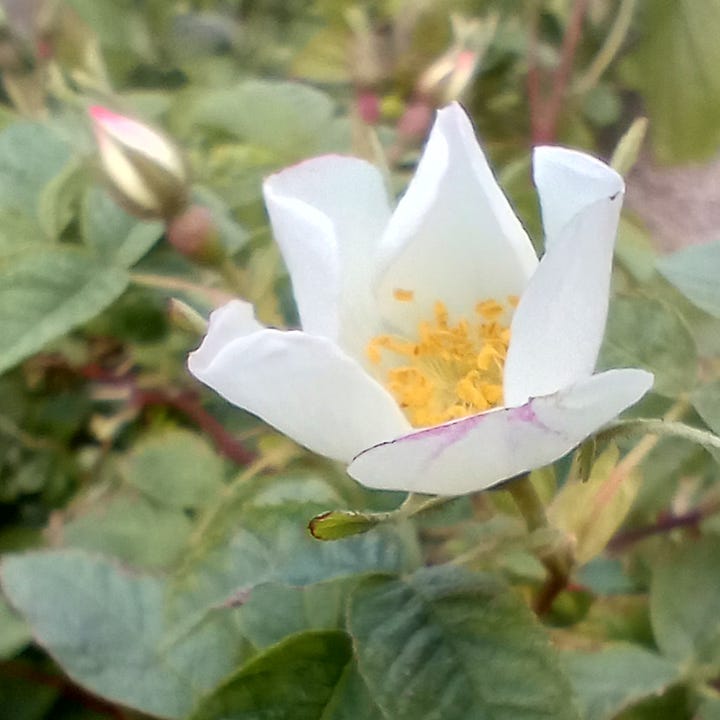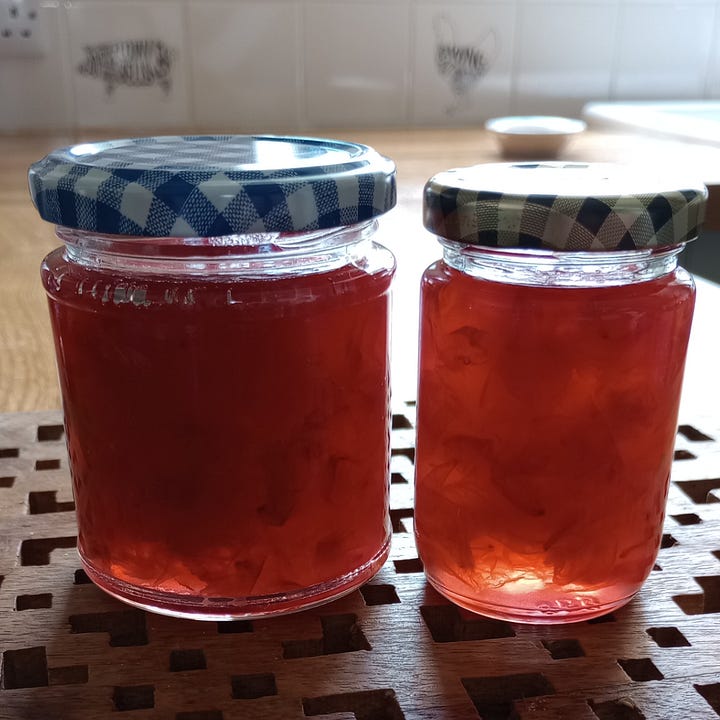As a teenager, my first singing teacher was a lovely old gent called Mr Cauldwell, who insisted on limiting my repertoire to florid Victoriana and music hall staples. One such song that I still find myself singing all these years later upon spotting my first wild roses of summer in the hedgerows, was based on a poem by Goethe - Heidenröslein - and set to music by Franz Schubert. The English translation’s first verse is as follows:
Once a boy a wild-rose spied
In the hedgerow growing,
Fresh in all her youthful pride,
When her beauties he descried,
Joy in his heart was glowing.
Little wild-rose, wild-rose red,
In the hedgerow growing.
(I’ve found a recording of it in the original German here, if you’d like to listen to it)
Of course, it turns out that rather than being a lovely peon to the wild rose, the Goethe poem is actually about a young man forcing his attentions on some poor girl, but I didn’t realise that at the time and it sadly doesn’t stop the earworm now, either!
Anyway, this is all simply to explain that I love wild roses in all of their forms, from the delicate white to the gaudy puce. When we moved into our current house six years ago, we planted an ‘edible’ hedge - a mix of saplings like hazelnut, wild rose, blackthorn, hawthorn, elder and a few others that all have edible flowers or fruits. This is the first summer that we’ve really seen the wild roses bloom fully and it has been exciting to watch each new bush erupt into flower - each seemingly a slightly different colour.
Sketching a wild rose (or roses) is something that I do every summer. It has become part of my seasonal rhythm - even if I don’t necessarily think about it consciously. I think part of the charm of sketching the wild rose is that they always look different - and even the palest-seeming flowers hold a range of colour within them if you start to look closely. This year I made my study using Faber-Castell watercolour pencils and I needed to use at least 8 or 9 shades in order to capture this single flower:


The yellow of the pollen-rich stamens reflects on the inside of the white petals, giving a soft glow; each petal is tipped by a hint of fuschia pink, whilst the petals themselves have cool grey shadows, as well as brighter white areas. I definitely haven’t captured it perfectly - but then that isn’t necessarily what I was trying to do. If I want a photo-realistic image, I can take a photograph - sketching for me is about capturing form, movement, essence. I try to lay aside my innate need for creating the ‘perfect’ sketch and instead simply enjoy the process of looking, touching, absorbing what nature is providing.
We’ve had so many roses on the hedge this year that in addition to providing plenty of sketchbook inspiration, I had the sudden realisation that I could finally attempt to make some rose petal jam that I’ve had on my to-do list for years - I even illustrated this recipe a couple of years ago as part of my 'A Rose for All Seasons' tea towel, which features a recipe for using wild rose petals to make a jam and then the autumn rosehips to make a syrup.

Once I realised that I could halve my quantities as part of the test (and wouldn’t need to strip all of my rose bushes completely!) it worked really well and I’ve got a couple of small jars of this beautiful, rose-flavoured, cheerful pink jam. We tried the jam on some fruit scones for tea last week and it was really delicious!
I purposefully chose deeper pink blooms for making my jam - enough to fill a 500ml jug, which I then filled with boiling water and left to steep overnight. By morning, the liquid was still a pale colour, but the magic happens when you pour it into your jam pan, slowly heat it with an equal quantity of sugar until dissolved and then add some lemon juice. At which point it turns bright pink!


To make rose petal jam:
Fill a 1l jug with rose petals - make sure you squash them down into the jug.
Add 500ml of boiling water to the jug, weight the petals down with something heavy and leave to steep overnight.
Pour your steeped water and petals into a deep saucepan or jam pan. Over a gentle heat, mix in 500g caster sugar until it has dissolved. Add the juice of a lemon (and watch the mixture change colour!)
Heat gently, stirring frequently, for about 25 minutes. Then bring the liquid to a rolling boil until it reaches the ‘jam’ point on a jam thermometer (you can also test for setting point by putting a small plate in the fridge before you start making your jam. After your liquid has been at a rolling boil for about 5 minutes, take out a teaspoon full and put it on the plate. Leave it about 30 secs and then push the drop gently with your finger. If wrinkles form, the jam is set and you can take the pan off the heat).
Pour into warm, sterilised jars (either washed in a dishwasher, or washed by hand and then dried in a low temperature oven), apply a lid and you’re done!




